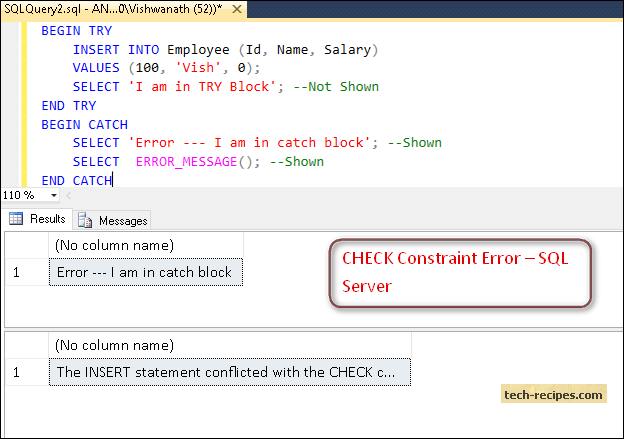

- #PHP TRY CATCH DOES NOT CATCH DATABASE ERROR HOW TO#
- #PHP TRY CATCH DOES NOT CATCH DATABASE ERROR CODE#
#PHP TRY CATCH DOES NOT CATCH DATABASE ERROR CODE#
SQL state: P0001 Code language: Shell Session ( shell ) Summary Output: ERROR: film with length 30 not found This is where you are able to handle the exception, log it, or ignore it. catch When an exception occurs, the Catch block of code is executed. If any code throws an exception within that try block, the exception will be handled by the corresponding catch. The following example is the same as the one above except that it uses the SQLSTATE codes instead of the condition names: do try A try block is used to encapsulate a region of code. SQL state: P0001 Code language: Shell Session ( shell ) 4) Handling exceptions as SQLSTATE codes Output: ERROR: The with length 90 is not uniqueĬONTEXT: PL/pgSQL function inline_code_block line 17 at RAISE

When sqlstate 'P0003' then raise exception 'The with length % is not unique', v_length catch exception exception when sqlstate 'P0002' then raise exception 'film with length % not found', v_length
#PHP TRY CATCH DOES NOT CATCH DATABASE ERROR HOW TO#
The following example illustrates how to catch multiple exceptions: do In this example, the too_many_rows exception occurs because the select into statement returns more than one row while it is supposed to return one row. SQL state: P0001 Code language: Shell Session ( shell ) Output: ERROR: Search query returns too many rowsĬONTEXT: PL/pgSQL function inline_code_block line 15 at RAISE The following example illustrates how to handle the too_many_rows exception: doīegin - select film select film_id, titleĮxception when too_many_rows then raise exception 'Search query returns too many rows' SQL state: P0001 Code language: Shell Session ( shell ) 2) Handling too_many_rows exception example $$ language plpgsql Code language: PostgreSQL SQL dialect and PL/pgSQL ( pgsql )ĬONTEXT: PL/pgSQL function inline_code_block line 14 at RAISE catch exception exception when no_data_found then raise exception 'film % not found', v_film_id But if you are specifying a different Exception type then. The following example uses the exception clause to catch the no_data_found exception and report a more meaningful message: do which Exception are you trying to catch the Exception should work. SQL state: P0002 Code language: Shell Session ( shell ) doīegin - select a film select film_id, titleĬode language: PostgreSQL SQL dialect and PL/pgSQL ( pgsql )ĬONTEXT: PL/pgSQL function inline_code_block line 6 at SQL statement The following example issues an error because the film with id 2000 does not exist. 1) Handling no_data_found exception example We’ll use the film table from the sample database for the demonstration. To handle other exceptions rather than the one you specify on the list, you can use the when others then clause. Codeigniter 3: Cant catch database error using try catch block php codeigniter-3 25,413 As for CI 3, below code gets database error code and error message. Code may be surrounded in a try block, to facilitate the catching of potential exceptions.

Typically, you will catch a specific exception and handle it accordingly. An exception can be throw n, and caught ( catch ed) within PHP. For example, P0002 for no_data_found and P0003 for too_many_rows. It’s also possible to specify the error condition by SQLSTATE code. For a complete list of condition names on the PostgreSQL website.

The condition names can be no_data_found in case of a select statement return no rows or too_many_rows if the select statement returns more than one row. In case there is no enclosing block with the exception clause, PL/pgSQL will abort the processing.


 0 kommentar(er)
0 kommentar(er)
